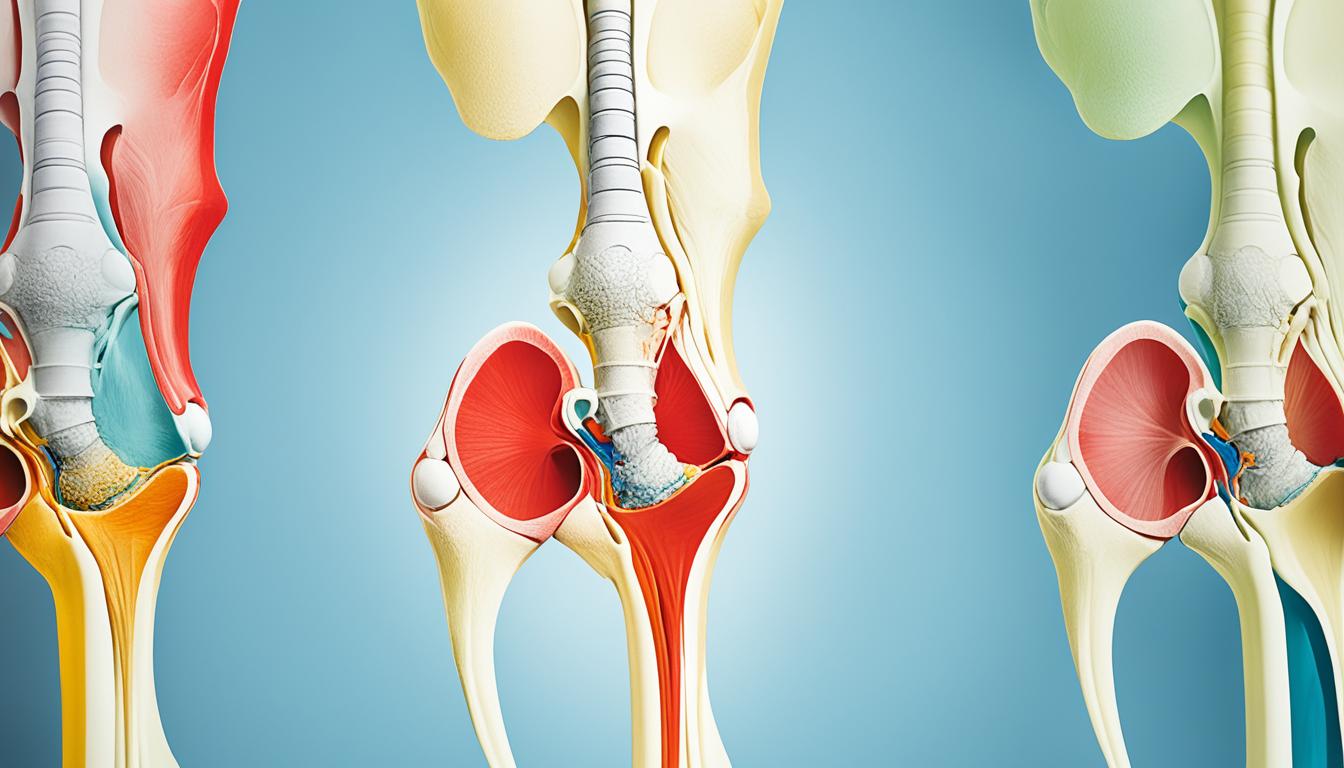Developmental dysplasia of the hip (DDH) affects the hip joint of babies and young children. It involves the hip joint not forming correctly, leading to various issues. The condition’s causes can be from genes, breech birth, or how the baby was positioned in the womb.
Girls and those with a family history of hip problems are at higher risk. So are firstborns and babies born breech. Early DDH detection is vital to avoid serious issues later. Doctors use physical exams, ultrasounds, x-rays, and MRIs to find and assess DDH.
DDH may show through uneven hips, a hip that clicks, or trouble moving the hip. Without treatment, it can cause hip problems and other health issues later in life. These include osteoarthritis, unstable hips, and different leg lengths.
There are both non-surgical and surgical ways to treat DDH. The simplest treatments involve harnesses or splints. More severe cases might need surgery. After any treatment, it’s crucial to have regular check-ups, do physical therapy, and follow a recovery plan.
A growing area of study is using stem cells or personalized treatments for DDH. The goal is to find the best, least invasive ways to treat it.
Key Takeaways:
- Developmental dysplasia of the hip (DDH) affects the hip joint in infancy.
- Signs of DDH include uneven hips, a clicking hip, and trouble moving it.
- Doctors use physical exams and imaging techniques to diagnose DDH.
- Treatments can be non-surgical or surgical, depending on the case.
- Many researchers are working on new, advanced ways to manage DDH, like stem cell therapy.
Types of Dysplasia: Developmental Dysplasia and Abnormal Growth Dysplasia
Dysplasia means abnormal cell development in tissues or organs. It can happen in various body parts. Two key types of dysplasia in kids are talked about: developmental and abnormal growth.
Developmental dysplasia, known as hip dysplasia or DDH, affects the hip joint. It might be there since birth or show up in the first year of life. It causes the hip joint to form wrong or move out of place. This leads to problems like one leg being longer than the other and an odd walk. DDH is a type of skeletal dysplasia.
Abnormal growth dysplasia is when cells or tissues grow wrong and might lead to cancer. It affects parts like the cervix, bone marrow, and skin, resulting in certain conditions. These include cervical dysplasia and myelodysplastic syndromes. Abnormal growth dysplasia includes ectodermal dysplasia and other growth problems.
Comparison of Developmental Dysplasia and Abnormal Growth Dysplasia
| Type of Dysplasia | Characteristics | Associated Complications |
|---|---|---|
| Developmental Dysplasia (DDH) | Abnormal development or displacement of the hip joint | Leg length discrepancy, hip instability, early-onset hip osteoarthritis |
| Abnormal Growth Dysplasia | Abnormal growth of cells or tissues | Increased risk of cancer, tissue-specific complications |
Each dysplasia type has its own risks, causes, and problems. Doctors need to be able to tell them apart to give the right care.
Knowing about dysplasia helps in correctly diagnosing and treating it. This improves how patients do.
Imaging Methods for Diagnosis and Management of DDH
Imaging methods are vital for checking and treating DDH. They give us a deeper look at the hip’s anatomy and any issues. This helps with correct diagnosis and making good treatment plans.
Ultrasonography (US)
Ultrasonography is key for spotting DDH early in babies. It’s safe and uses sound waves. This let’s doctors see if the hip has any problems or is not in the right place.
X-ray or Radiography
X-rays are also used to diagnose DDH, more so in older infants and kids. They show the bones clearly. This helps doctors confirm the diagnosis and check how severe the issue is.
Magnetic Resonance Imaging (MRI)
MRI scans give clear views of soft tissues and bones. They’re great for tricky cases of DDH. Doctors get detailed images to help figure out the best care.
Computed Tomography (CT)
CT scans are detailed but use more radiation than X-rays. They’re not often used for DDH diagnosis. Doctors turn to them for complex cases, when they need a closer look at bone problems.
Choosing the right imaging method depends on things like the patient’s age and how serious the DDH is. These tools help doctors to pinpoint DDH and plan the best ways to treat it. This can lead to better results for patients.
Conclusion
Developmental dysplasia of the hip (DDH) impacts the hip joint in babies and young kids. It’s important to find it early and treat it well to avoid problems later.
Doctors use exams, ultrasound, X-rays, and MRIs to spot DDH. These tests show what’s going on in the hip, helping doctors choose the best treatment.
DDH treatments change based on how bad it is and the child’s age. They can range from wearing special items to surgery. New treatments are being developed to make care even better in the future.
Thanks to research, doctors are getting better at treating DDH. Early finding, the right diagnosis, and fitting treatment can help a child’s hip grow right and keep them healthy. This leads to a better life for those with DDH.

